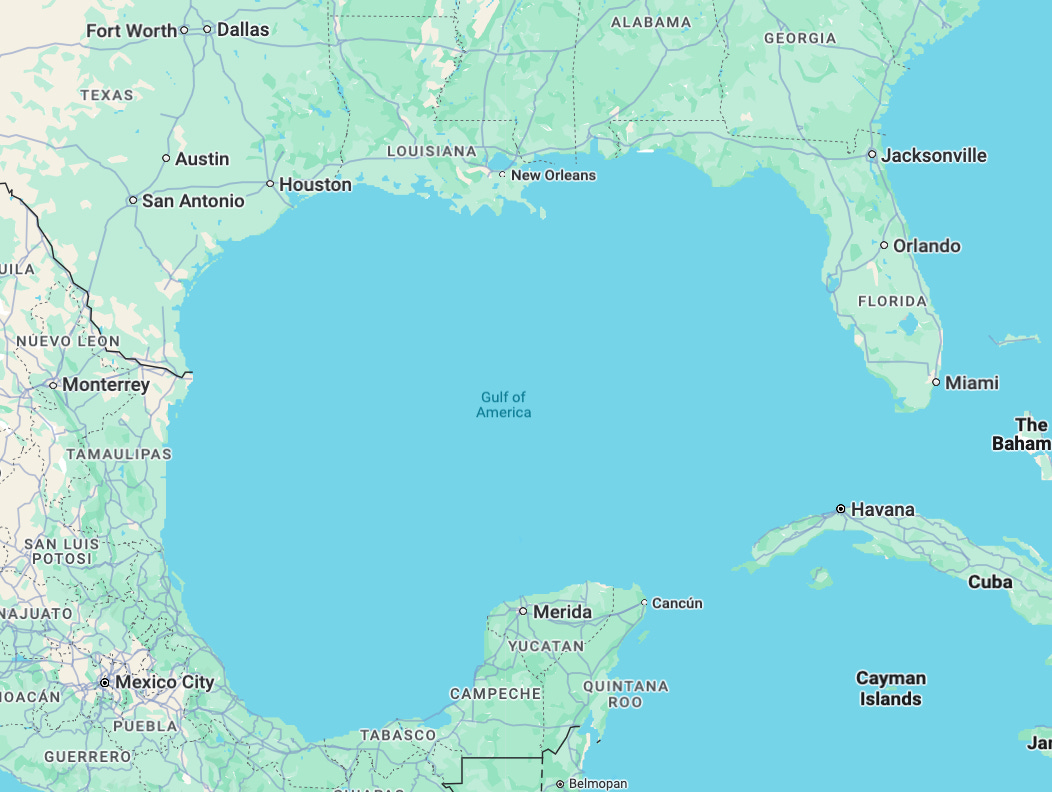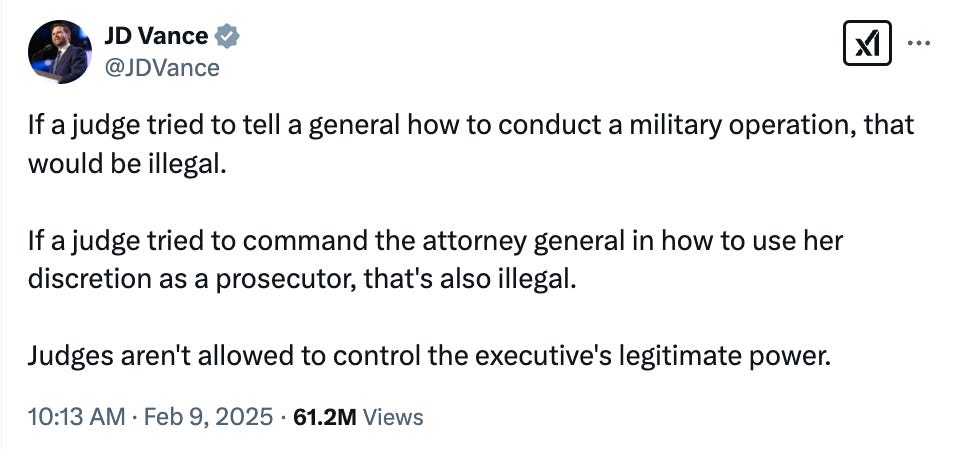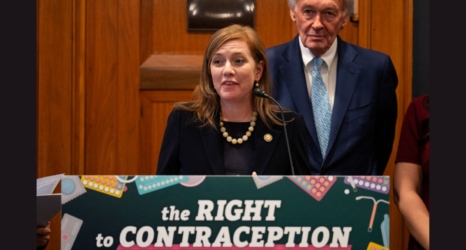Trump and Musk are testing the limits, trying to sell America on being an authoritarian state—but they can’t do it unless we allow them to do so.

Originally published in the Substack Law Dork.
President Donald Trump and shadow-president Elon Musk are losing.
When Justice Department lawyers go to court, trying to defend many of Trump and Musk’s actions, DOJ has regularly lost—and often face tense moments in court before being dealt those losses.
On Monday, for example, Judge John Bates, a George W. Bush appointee, heard arguments over a group of doctors’ lawsuit challenging the removal of webpages and datasets by the Centers for Disease Control and Prevention (CDC), Food and Drug Administration (FDA) and Department for Health and Human Services (HHS) as part of the government-wide censorship purge put into effect following Trump’s Jan. 20 executive order defining “sex” to exclude transgender people.
James Harlow, the DOJ lawyer defending the Trump administration’s actions, kept trying to insist this was mere “website maintenance” and couldn’t constitute final agency action—a necessary step in challenging the policy.
Bates wasn’t buying it, eventually telling Harlow that “termination” of the sites seemed pretty final to him.
Later in Harlow’s argument, it got more heated, with Bates sternly telling the DOJ lawyer not to question him—prompting a quick, and unusual, apology.
On Tuesday, Bates issued an order that HHS, CDC and FDA put back up the websites and datasets cited by the doctors in their briefing by 11:59 p.m. Tuesday.
“By removing long relied upon medical resources without explanation, it is likely that the each agency failed to ‘examine the relevant data and articulate a satisfactory explanation for its action including a rational connection between the facts found and the choice made,’” he wrote in his opinion. “Hand in hand with the lack of explanation, it is also likely that the agencies ‘failed to consider’ the ‘important’ issue of the substantial reliance by medical professionals on the removed webpages.“
Trump, through his orders, and Musk, through DOGE, are testing the limits and seeing what they can get away with. A step beyond claiming unearned powers, they are just presuming they have them and seeing if anyone stops them. It is an attempt at lawlessness—or, rather, at them being the law.
Part of this has already been a challenge to legislative authority; there undoubtedly are the beginnings of challenges to judicial authority as well. On both fronts, though, I think it is a little more complicated than what you’re hearing.
As I said, there has been judicial pushback.
Judge John Coughenour, the Reagan appointee who heard the first arguments over Trump’s executive order to end birthright citizenship, asked how the DOJ lawyers could state that it is constitutional before issuing a temporary restraining order against implementation.
Judge Royce Lamberth, another Reagan appointee, wrote that he couldn’t see “any” public interest in immediately halting transgender prisoners gender-affirming medical care before blocking that part of a different Trump executive order.
In hearing after hearing and ruling after ruling, judges have been sharp when needed to challenge the administration’s moves when they intrude on the legislative function, ignore established laws or violate the Constitution.
The anti-birthright citizenship order has been blocked by preliminary injunction three times now; Lamberth blocked enforcement of the order that would force trans women in federal prison to be housed with men and end all trans-related medical care; the Office of Management and Budget grants and loans “pause” was blocked and then rescinded and then blocked again, even under any other name; the USAID “administrative leave” directives have been blocked; access to Treasury systems has been restricted; and a judge on Monday evening blocked the indirect costs rate cap issued Feb. 7 by the National Institutes of Health, as applied to states that sued over the act on Monday morning.

And yet, if you look around, that is not the general understanding of the first three weeks of the second Trump administration. Instead, the general views seem to be either that what Trump is doing is fine and good or that it is unconstitutional, illegal lawlessness—but, in either event and whether implicit or explicit, the end result is inevitable and Trump is winning.
That’s wrong, and I want to explain why—not because I think we are safe from the very dangerous consequences being discussed, but because those consequences are not inevitable even though Trump and Musk and their allies want you to think they are.
We are seeing Trump take these executive actions because he almost certainly would not be able to get many of them through Congress.
I do not see that as a minor distinction. Trump is a salesman, as is Musk, and they are both trying to sell America on being an authoritarian state—but they can’t do it unless we allow them to do so.
The courts are not the solution, although courts play a key role. This requires, instead, a whole-of-democracy solution.
What’s a Win?
It is important to realize that many of the administration’s so-called “wins” in the first three weeks have come when entities preemptively accede to Trump’s wishes without even challenging them. Whether you refer to it as “obeying in advance,” to use Timothy Snyder’s turn of phrase, or one of the less appropriate phrases that I have used at times, it’s that. The White House put out press statements promoting the NCAA giving in to the threats in Trump’s anti-trans sports order and a small handful of hospitals reviewing or stopping the provision of gender-affirming medical care for minors after that anti-trans order. And, of course, Google Maps forced me to see “Gulf of America” on my phone on Monday night.

Additionally, though, it is important to remember that the presidency is very powerful and that there are many things—if done with the proper process, constitutionally, and within his areas of authority—that Trump absolutely can do.
But a lot of what we’re seeing now is going far outside of those lines with actions that Trump just doesn’t have the authority to take under our constitutional system or under current law. Many actions, specifically, raise significant questions about Trump and Musk’s authority to stop the federal government from spending appropriated funds and regarding Trump’s authority to fire certain people.
What’s more, it’s important to take a step back and realize that we are seeing Trump take these executive actions because he almost certainly would not be able to get many of them through Congress—if he actually sought to defund certain agencies, pass certain laws, change how certain officials are appointed, and so on.
It is a nearly unprecedented series of lawless or arguably lawless actions. All in the first three weeks.
This, then, leads to the other questions.
Who Will Stop Him?
I’ve already discussed that the U.S. Supreme Court’s 2024 immunity ruling does not mean Trump can do anything, but, if he can’t, who can stop him? Well, under our system, this is checks and balances. This is separation of powers. These are the very high-level “how does our government work?” that now appear to need to be reworded to: “How is our government supposed to work?”
First, there is Congress. We have seen, thus far, little pushback there. The closest we came was that one brief moment when everyone joined together to keep Matt Gaetz from becoming attorney general. And yet, even there, no senator actually had to vote against Trump’s nominees. For other nominees, it has become clear that—at least on executive branch nominations—Republican senators are very weak. (And some Democrats have supported some nominees.)
But, that doesn’t necessarily mean Congress will be worthless. First, there has been pressure to get Democrats to take actions that would make running the Senate much more difficult for Republicans by constantly denying unanimous consent. Second, there is a difference between executive branch appointees, judicial appointees, and legislation—and some senators treat them differently when it comes to their votes. And, finally, when it comes to legislation, you add the House in with its razor-thin Republican majority and, in most instances, the number of Senate votes needed for passage increases to 60 to invoke cloture. There is already discussion of how Democrats can leverage the upcoming funding bill.
Then, within our current system, there are the courts. We have a lopsided 6-3 Republican-appointed Supreme Court, but, when it comes to specific challenges to specific actions, we cannot rule out the lower courts or even the Supreme Court to push back. (And, as I have argued, if they don’t want to do so, they should be forced to own their part in Trump’s lawlessness.)
First, process and procedure matters. As was seen when the court rejected the first Trump administration’s Census citizenship question, taking actions improperly can stymie actions that the court might even approve of if done properly. Sometimes, though, the court will be forced to rule beyond issues like standing, process and procedure, and then the justices might need to make hard decisions—on the merits—that could affect the future of this country.
There are also the states. Federalism, we have already seen, will play a key role in stopping Trump’s lawlessness. Not only in terms of litigation, but also in terms of state and local policies going further than—and sometimes conflicting with—Trump administration policies. States often can fight back in a way that even willing and eager congressional Democrats cannot. Twenty-two states filed the lawsuit Monday morning challenging the NIH indirect costs rate cap. The lawsuit came less than 72 hours after the unexpected NIH action was issued.
But Aren’t They Just Ignoring the Courts?
It’s important to pull apart what this means. It could mean a direct order from Trump to ignore a court’s ruling. I’m not going to hide from that, and will address it. But, there are several other things that happen that are leading to people saying that the Trump administration is ignoring court orders.
First, this is all happening very quickly. Although, as judges have said, that is of the Trump administration’s doing, it is an important reality. The orders are coming quickly. It also means lawsuits are being put together quickly. Hearings—generally involving government lawyers at DOJ, not the agency being sued—are happening quickly. And, at times, court orders are being issued quickly.
At any of those points, mistakes can get made. A hastily drafted order or directive can overstate its aims. A lawsuit can miss an important claim. A DOJ lawyer can be uninformed—or misinformed—about some aspect of what is happening at the agency involved in a case. A judge can issue an order not quite aware of all of the implications of the language used in one sentence. An agency head can believe they’re not covered by an order—or not even know about it.
Or course, all of those things can be intentional, too. An order or directive can use broad language to intimidate. A lawsuit can strategically avoid a claim for lawyers to preserve it for another case should the initial lawsuit fail. A DOJ lawyer can avoid knowing things to be able to represent something better to the court. (Or, yes, they could intentionally misrepresent facts to the court, but that comes later.) A judge can issue a broad order to send a message—even if they don’t expect it to stand. An agency head can say they’re not covered by an order—even when they think they’re on the line.
But, it is important, in all of this, to note what DOJ is saying in court and putting in its papers.
Let’s Deal With Specifics
Didn’t the Trump administration ignore the pause on the grants and loans “pause”?
Initially, when the first court issued the first order blocking the “pause,” DOJ began arguing that alternate authorities, beyond the OMB memo, justified various funding pauses that did not end following that order. That did not succeed in a hearing in the second court, leading to the second, more broad order. It was a losing argument, in other words, but it was an argument.
Plaintiffs absolutely are going to, and should, argue in support of their position when they see evidence of an order not apparently being followed, but it’s important to note, legally, what has happened here. DOJ did not argue that the government did not need to follow the courts’ orders; they were arguing that they were working to comply, given their understanding of the order.
On Monday, the judge in that second case, Judge John McConnell wrote, “The Court disagrees with the Defendants’ [characterization of the initial TRO]. The Court’s TRO is clear and unambiguous in its scope and effect, which is inconsistent with the Defendant’s interpretation contained in the Notice.“
The Justice Department filed a notice that it was appealing the order. Now, although TROs aren’t generally appealable (an issue we will deal with at another time), the fact that their response was to appeal is, indirectly, an acknowledgement of the court’s authority—even if DOJ disagrees with the ruling.
What about the claims they’ve made in court that have been false?
As I discussed on Bluesky on Monday night, DOJ filed two “notice of correction” filings to start off the week. Not a good look, but the lawyers in both cases appear, essentially, to be saying that everything was too rushed and over the weekend they were able to get clarification about specifics of the cases—aspects of actions taken within USAID, in the one case, and the employment status of one of the people central to the litigation over access to the Treasury Department’s payment systems.
In short, there are extremely troubling signs about the way that Trump and Musk would like to run the country. Thus far, however, DOJ lawyers do appear to be seeking a way to advance Trump’s claims in courts while trying to then implement courts’ orders if and when those claims fail.
Yes, it will be a moving-target, whack-a-mole situation—as I was writing this, Judd Legum and Noel Sims reported at Popular Information that NIH funding remains largely frozen—a clear example of the Trump administration’s goal of seeking to exhaust us. But, a key thing to watch is whether DOJ is seeking explanations and following court orders.
It won’t always be questions about the Trump administration. Over the weekend, Sen. Tom Cotton, law professor Adrian Vermeule, and Vice President JD Vance were posting on X about a Feb. 8 court order that they asserted went beyond the judge’s authority to issue. It was a rather broad order blocking “political appointees, special government employees, and government employees detailed from an agency outside the Treasury Department“ from accessing Treasury payment systems. This, they complained, blocked Treasury Secretary Scott Bessent from accessing the systems he oversees.
Despite their bluster, though, look to what DOJ actually did: They went to the court, seeking to have the court “dissolve, clarify, or modify” the order. They made arguments, a response was filed and the court ruled on Monday—removing Senate-confirmed political appointees from coverage under the order.
What if They Do Ignore the Courts?
Eventually, yes, it does appear likely that Trump and/or Musk want to challenge—or at least are not opposed to challenging—the courts’ authority to enforce orders.
Vance’s post over the weekend signaled the coming danger.

Effectively, this is no different than Trump’s most empty executive orders. Vance is making the first two statements, which, with some narrow exceptions, are generally true statements, in order to make the third claim. The problem with the third claim, however, is that it both shifts and expands. Although it could be read narrowly, it also can easily be read as an excuse for some later refusal to follow a court’s order that Trump determines is “illegitimate.”
It is the courts’ role to decide whether the executive is exercising “legitimate” or “illegitimate” power.
Vance’s argument, very quietly, suggests that sometimes it is not.
What Then?
This is, in a way, takes us full circle. We are back to the country’s founding—to the Federalist Papers and Alexander Hamilton’s Federalist No. 78, in which he details that “the judiciary is beyond comparison the weakest” of the three branches because it lacks both the “sword” and the “purse.”
As Hamilton wrote:
The Executive not only dispenses the honors, but holds the sword of the community. The legislature not only commands the purse, but prescribes the rules by which the duties and rights of every citizen are to be regulated. The judiciary, on the contrary, has no influence over either the sword or the purse; no direction either of the strength or of the wealth of the society; and can take no active resolution whatever. It may truly be said to have neither FORCE nor WILL, but merely judgment; and must ultimately depend upon the aid of the executive arm even for the efficacy of its judgments.
Trump and Musk have made it clear that they want to dispense the honors, hold the sword, command the purse and prescribe the rules. Musk’s agency-shuttering funding “freezes” and Trump’s executive orders go to those latter, legislative ends.
The illegal and unconstitutional actions need to be challenged in court, and they are being challenged. Congress needs to assert itself soon as well, before its powers atrophy. Everyone, at every level of government must use their powers to stop Trump and Musk’s illegal and unconstitutional overreach. And the public must be engaged—informing themselves about the steps Trump and Musk are taking in their name and then pushing back.
The ultimate question here, though, is what happens if and when a court says no to Trump or Musk and they say the court’s order is illegitimate.
Yes, if it gets to that point, it gets very bad.
Justice Department lawyers, from Attorney General Pam Bondi on down, would need to make life-changing—but essential—decisions immediately. And though Bondi’s entrance suggests she will likely go along with much of what Trump does, outright defiance of a court order would be a new, lawless line she would need to choose to cross at that moment.
I know there has been lots of talk of contempt, the U.S. Marshals Service, and whether the Marshals would listen to the courts. Those are important procedural questions, but—aside from isolated actions from a runaway agency—I think they almost mask the point of where we would be in a moment of outright defiance of a court’s orders.
If we get there, Congress, the courts, and the states will have essential roles in immediately pushing back, as will the public. People will make decisions that will stay with them for life, and everyone will need to take every action they can to stop the lawlessness. And, the rule of law might not win.
But, despite the horrible and very real things that have happened in the first three weeks of the second Trump administration, we are not there yet.
Don’t let Donald Trump and Elon Musk, with JD Vance running along behind, convince you otherwise.
Don’t let them talk us out of democracy.












